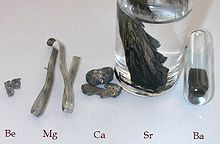WORKSHEET HERE
The alkaline earth metals are six chemical elements in group 2 of the periodic table. They are beryllium (Be), magnesium (Mg), calcium (Ca), strontium (Sr), barium (Ba), and radium (Ra).[1] The elements have very similar properties: they are all shiny, silvery-white, somewhat reactive metals at standard temperature and pressure.[2]
Structurally, they have in common an outer s- electron shell which is full;[2][3][4] that is, this orbital contains its full complement of two electrons, which these elements readily lose to form cations with charge +2, and an oxidation state of +2.[5]
All the discovered alkaline earth metals occur in nature.[6] Experiments have been conducted to attempt the synthesis of element 120, the next potential member of the group, but they have all met with failure.
Characteristics
Chemical
As with other groups, the members of this family show patterns in their electronic configuration, especially the outermost shells, resulting in trends in chemical behavior:
| Z | Element | No. of electrons/shell | Electron configuration[n 1] |
|---|---|---|---|
| 4 | beryllium | 2, 2 | [He] 2s2 |
| 12 | magnesium | 2, 8, 2 | [Ne] 3s2 |
| 20 | calcium | 2, 8, 8, 2 | [Ar] 4s2 |
| 38 | strontium | 2, 8, 18, 8, 2 | [Kr] 5s2 |
| 56 | barium | 2, 8, 18, 18, 8, 2 | [Xe] 6s2 |
| 88 | radium | 2, 8, 18, 32, 18, 8, 2 | [Rn] 7s2 |
Most of the chemistry has been observed only for the first five members of the group. The chemistry of radium is not well-established due to its radioactivity;[2] thus, the presentation of its properties here is limited.
The alkaline earth metals are all silver-colored and soft, and have relatively low densities, melting points, and boiling points. In chemical terms, all of the alkaline metals react with the halogens to form the alkaline earth metal halides, all of which are ionic crystalline compounds (except for beryllium chloride, which is covalent). All the alkaline earth metals except beryllium also react with water to form strongly alkaline hydroxides and, thus, should be handled with great care. The heavier alkaline earth metals react more vigorously than the lighter ones.[2] The alkaline metals have the second-lowest first ionization energies in their respective periods of the periodic table[4] because of their somewhat low effective nuclear charges and the ability to attain a full outer shell configuration by losing just two electrons. The second ionization energy of all of the alkaline metals is also somewhat low.[2][4]
Beryllium is an exception: It does not react with water or steam, and its halides are covalent. If beryllium did form compounds with an ionization state of +2, it would polarize electron clouds that are near it very strongly and would cause extensive orbital overlap, since beryllium has a high charge density. All compounds that include beryllium have a covalent bond.[7] Even the compound beryllium fluoride, which is the most ionic beryllium compound, has a low melting point and a low electrical conductivity when melted.[8][9][10]
All the alkaline earth metals have two electrons in their valence shell, so the energetically preferred state of achieving a filled electron shell is to lose two electrons to form doubly charged positive ions.
Compounds and reactions[edit]
The alkaline earth metals all react with the halogens to form ionic halides, such as calcium chloride (CaCl
2), as well as reacting with oxygen to form oxides such as strontium oxide (SrO). Calcium, strontium, and barium react with water to produce hydrogen gas and their respective hydroxides, and also undergo transmetalation reactions to exchange ligands.
-
Alkaline earth metals fluorides solubility-related constants[n 2] Metal M2+
HE
[11][clarification needed]F−
HE
[12][clarification needed]“MF2”
unit
HEMF2
lattice
energies
[13]Solubility
[14][clarification needed]Be 2,455 458 3,371 3,526 soluble Mg 1,922 458 2,838 2,978 0.0012 Ca 1,577 458 2,493 2,651 0.0002 Sr 1,415 458 2,331 2,513 0.0008 Ba 1,361 458 2,277 2,373 0.006
Physical and atomic[edit]
The table below is a summary of the key physical and atomic properties of the alkaline earth metals.
| Alkaline earth metal | Standard atomic weight (u)[n 3][16][17] |
Melting point (K) |
Melting point (°C) |
Boiling point (K)[4] |
Boiling point (°C)[4] |
Density (g/cm3) |
Electronegativity (Pauling) |
First ionization energy (kJ·mol−1) |
Covalent radius (pm)[18] |
Flame test color | |
|---|---|---|---|---|---|---|---|---|---|---|---|
| Beryllium | 9.012182(3) | 1560 | 1287 | 2742 | 2469 | 1.85 | 1.57 | 899.5 | 105 | White[19] | |
| Magnesium | 24.3050(6) | 923 | 650 | 1363 | 1090 | 1.738 | 1.31 | 737.7 | 150 | Brilliant-white[2] | |
| Calcium | 40.078(4) | 1115 | 842 | 1757 | 1484 | 1.54 | 1.00 | 589.8 | 180 | Brick-red[2] | |
| Strontium | 87.62(1) | 1050 | 777 | 1655 | 1382 | 2.64 | 0.95 | 549.5 | 200 | Crimson[2] | |
| Barium | 137.327(7) | 1000 | 727 | 2170 | 1897 | 3.594 | 0.89 | 502.9 | 215 | Apple-green[2] | |
| Radium | [226][n 4] | 973 | 700 | 2010 | 1737 | 5.5 | 0.9 | 509.3 | 221 | Crimson red[n 5] | |
Nuclear stability[edit]
|
This section needs expansion. You can help by adding to it. (November 2012)
|
Of the six alkaline earth metals, beryllium, calcium, barium, and radium have at least one naturally occurring radioisotope; magnesium and strontium do not. Beryllium-7, beryllium-10, and calcium-41 are trace radioisotopes; calcium-48 and barium-130 have very long half-lives and thus occur naturally on earth; and all isotopes of radium are radioactive. Calcium-48 is the lightest nuclide to undergo double beta decay.[21]Calcium and barium are weakly radioactive: calcium contains about 0.1874% cacium-41,[22] and barium contains about 0.1062% barium-130.[23]
History[edit]
Etymology[edit]
The alkaline earth metals are named after their oxides, the alkaline earths, whose old-fashioned names were beryllia, magnesia, lime, strontia, and baryta. These oxides are basic (alkaline) when combined with water. “Earth” is an old term applied by early chemists to nonmetallic substances that are insoluble in water and resistant to heating—properties shared by these oxides. The realization that these earths were not elements but compounds is attributed to the chemist Antoine Lavoisier. In his Traité Élémentaire de Chimie (Elements of Chemistry) of 1789 he called them salt-forming earth elements. Later, he suggested that the alkaline earths might be metal oxides, but admitted that this was mere conjecture. In 1808, acting on Lavoisier’s idea, Humphry Davy became the first to obtain samples of the metals by electrolysis of their molten earths,[24] thus supporting Lavoisier’s hypothesis and causing the group to be named the alkaline earth metals.
Discovery[edit]
The calcium compounds calcite and lime have been known and used since prehistoric times.[25] The same is true for the beryllium compounds beryl and emerald.[26] The other compounds of the alkaline earth metals were discovered starting in the early 15th century. The magnesium compound magnesium sulfate was first discovered in 1618 by a farmer at Epsom in England. Strontium carbonate was discovered in minerals in the Scottish village of Strontian in 1790. The last element is the least abundant: radioactive radium, which was extracted from uraninite in 1898.[27][28][29]
All elements except beryllium were isolated by electrolysis of molten compounds. Magnesium, calcium, and strontium were first produced by Humphry Davy in 1808, whereas beryllium was independently isolated by Friedrich Wöhler and Antoine Bussy in 1828 by reacting beryllium compounds with potassium. In 1910, radium was isolated as a pure metal by Curie and André-Louis Debierne also by electrolysis.[27][28][29]
Beryllium[edit]

Emerald, a variety of beryl, the mineral that beryllium was first known to be in.
Beryl, a mineral that contains beryllium, has been known since the time of the Ptolemaic Kingdom in Egypt.[26] Although it was originally thought that beryl was an aluminium silicate,[30] beryl was later found to contain a then-unknown element when, in 1797, Louis-Nicolas Vauquelin dissolved aluminium hydroxide from beryl in an alkali.[31] In 1828, Friedrich Wöhler[32] and Antoine Bussy[33] independently isolated this new element, beryllium, by the same method, which involved a reaction of beryllium chloride with metallic potassium; this reaction was not able to produce large ingots of beryllium.[34] It was not until 1898, when Paul Lebeau performed an electrolysis of a mixture of beryllium fluorideand sodium fluoride, that large pure samples of beryllium were produced.[34]
Magnesium[edit]
Magnesium was first produced by Sir Humphry Davy in England in 1808 using electrolysis of a mixture of magnesia and mercuric oxide.[35] Antoine Bussy prepared it in coherent form in 1831. Davy’s first suggestion for a name was magnium,[35] but the name magnesium is now used.
Calcium[edit]
Lime has been used as a material for building since 7000 to 14,000 BCE,[25] and kilns used for lime have been dated to 2,500 BCE in Khafaja, Mesopotamia.[36][37] Calcium as a material has been known since at least the first century, as the ancient Romans were known to have used calcium oxide by preparing it from lime. Calcium sulfate has been known to be able to set broken bones since the tenth century. Calcium itself, however, was not isolated until 1808, when Humphry Davy, in England, used electrolysis on a mixture of lime and mercuric oxide,[38] after hearing that Jöns Jakob Berzelius had prepared a calcium amalgam from the electrolysis of lime in mercury.
Strontium[edit]
In 1790, physician Adair Crawford, who had been working with barium, realized that Strontian ores showed different properties than other supposed ores of barium.[39] Therefore, he concluded that these ores contained new minerals, which were named strontites in 1793 by Thomas Charles Hope, a chemistry professor at the University of Glasgow,[40] who confirmed Crawford’s discovery. Strontium was eventually isolated in 1808 by Sir Humphry Davy by electrolysis of a mixture of strontium chloride and mercuric oxide. The discovery was announced by Davy on 30 June 1808 at a lecture to the Royal Society.[41]
Barium[edit]
Barite, a mineral containing barium, was first recognized as containing a new element in 1774 by Carl Scheele, although he was able to isolate only barium oxide. Barium oxide was isolated again two years later by Johan Gottlieb Gahn. Later in the 18th century, William Withering noticed a heavy mineral in the Cumberland lead mines, which are now known to contain barium. Barium itself was finally isolated in 1808 when Sir Humphry Davy used electrolysis with molten salts, and Davy named the element barium, after baryta. Later, Robert Bunsen and Augustus Matthiessen isolated pure barium by electrolysis of a mixture of barium chloride and ammonium chloride.[42][43]
Radium[edit]
While studying uraninite, on 21 December 1898, Marie and Pierre Curie discovered that, even after uranium had decayed, the material created was still radioactive. The material behaved somewhat similarly to barium compounds, although some properties, such as the color of the flame test and spectral lines, were much different. They announced the discovery of a new element on 26 December 1898 to the French Academy of Sciences.[44] Radium was named in 1899 from the word radius, meaning ray, as radium emitted power in the form of rays.[45]
Occurrence[edit]
Beryllium occurs in the earth’s crust at a concentration of two to six parts per million (ppm),[46] much of which is in soils, where it has a concentration of six ppm. Beryllium is one of the rarest elements in seawater, even rarer than elements such as scandium, with a concentration of 0.2 parts per trillion.[47][48] However, in freshwater, beryllium is somewhat more common, with a concentration of 0.1 parts per billion.[49]
Magnesium and calcium are very common in the earth’s crust, with calcium the fifth-most-abundant element, and magnesium the eighth. None of the alkaline earth metals are found in their elemental state, but magnesium and calcium are found in many rocks and minerals: magnesium in carnallite, magnesite, and dolomite; and calcium in chalk, limestone, gypsum, and anhydrite.[2]
Strontium is the fifteenth-most-abundant element in the Earth’s crust. Most strontium is found in the minerals celestite and strontianite.[50] Barium is slightly less common, much of it in the mineral barite.[51]
Radium, being a decay product of uranium, is found in all uranium-bearing ores.[52] Due to its relatively short half-life,[53] radium from the Earth’s early history has decayed, and present-day samples have all come from the much slower decay of uranium.[52]



